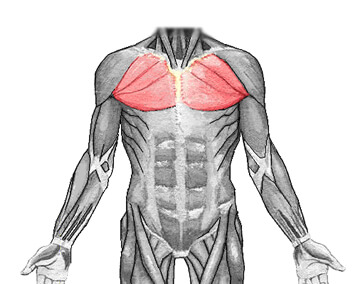What is the name of the bone that protects your brain?
The skull.

What are these muscles called?
The pectoral muscles.
SIGHT
Organ:
Receptor:
Stimulus:
Nerve:
SIGHT
Organ: eye
Receptor: in the retina
Stimulus: reflected light
Nerve: optic
What is the other name we use for the locomotor system?
The musculoskeletal system.
What are the two (2) parts of the nervous system?
The central and the peripheral nervous system.
What is the name of the bone that protects your lungs?
The ribcage.

What are these muscles called?
The dorsal muscles.
HEARING
Organ:
Receptor:
Stimulus:
Nerve:
HEARING
Organ: ear
Receptor: in the cochlea
Stimulus: sound waves
Nerve: auditory
What are the three (3) parts that make up the musculoskeletal system?
The bones, the muscles, and the joints.
What are the two (2) parts of the central nervous system?
The brain and the spinal cord.
What is the name of the bone referred to as your "hips"?
The pelvis.
What is the biggest muscle in your body?
The gluteus.
SMELL
Organ:
Receptor:
Stimulus:
Nerve:
SMELL
Organ: nose
Receptor: cells inside nostrils
Stimulus: chemicals in the air
Nerve: olfactory
Name the three (3) types of muscles and explain what they are.
The skeletal, the smooth, and the cardiac muscles.
The skeletal muscles refer to muscles attached to bones.
The smooth muscles refer to the organs in our body.
The cardiac muscles refer to the heart.
What is the peripheral nervous system?
The peripheral nervous system is a system of nerves that sends information to the brain.
What are the three (3) major bones in the arm?
The humerus, the radius, and the ulna.
What are the three (3) major muscles in the arm?
The deltoids, the biceps, and the triceps.
TASTE
Organ:
Receptor:
Stimulus:
Nerve:
TASTE
Organ: tongue
Receptor: taste buds
Stimulus: chemicals in food
Nerve: gustatory
Name the three types and give an example of each.
A joint is where two bones are connected. There are three types:
A fixed joint (ej. parts of the skull).
A semi-flexible joint (ej. in the spine).
A flexible joint (ej. in the knee).
What is the function of the spinal cord?
The spinal cord connects the brain and nerves and controls reflexes.
What are the four (4) major bones in the leg?
The femur, the patella, the tibia, and the fibula.
What are the three (3) major muscles in the leg?
The quadriceps, the biceps femoris, and the gastrocnemius.
BONUS POINT: What is the more commonly known name of the biceps femoris?
TOUCH
Organ:
Receptor:
Stimulus:
Nerve:
TOUCH
Organ: skin
Receptor: in the dermis
Stimulus: pressure, texture, heat, pain
Nerve: many sensory nerves in the peripheral nervous system
Explain how the central nervous system responds to a stimulus.
The central nervous system sends out an impulse along the axons of motor neurons.
The motor neurons pass the impulse along until it reaches the effectors.
Name the three (3) parts of the brain and describe what they are responsible for.
The cerebrum, the cerebellum, and the brain stem.
The cerebrum is responsible for your thoughts, memory, feelings, decision-making, and interpreting stimuli.
The cerebellum is responsible for movement, balance, and coordination.
The brain stem is responsible for involuntary actions and sleeping.